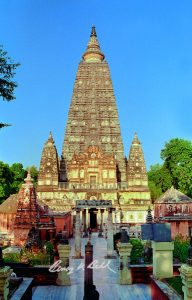The story of Buddhism

Benoy K Behl
The art of Buddhism is some of the most gentle and sublime art of the world. This exquisite heritage of philosophy and art developed in India and spread to all the countries of Asia.
The exquisite art of Buddhism takes us to a peaceful sanctuary, far from the clamour of the material world. Through their lilting grace, these paintings and sculptures remind us that there is an end to the sorrow of the world, and that this is through a deep sense of compassion for the whole of creation.
The four great Buddhist pilgrimage sites of Lumbini, Bodhgaya, Sarnath and Kushinagar are among the most revered places in the world. These are held sacred by more than 353,141,000 Buddhists and even today vast numbers of pilgrims come to these sites from all the Asian countries. These four sites are depicted, as well as the site of Kapilavastu, where the Buddha lived as Prince Siddhartha.
Emperor Ashok in the 3rd century BC was the first great royal patron to honor Buddhist sites. The great stupas which he made, his commemorative pillars and sculptural railings are some of the most beautiful and oldest surviving architecture and art of the subcontinent.
From the time of Ashok onwards, Buddhism spread not only to all corners of India but also all over Asia. The religion and the art associated with it had a transforming effect on the countries which it reached and, till today, Buddhism flourishes all over the continent.
In the 1st century AD, the Kushana King Kanishka gave royal patronage to Mahayana Buddhism. Thereafter the Mahayana tradition, which later also developed into the Vajrayana tradition, became dominant in India. This form of Buddhism also travelled northwards from Kashmir to the trans-Himalayan regions and to China, Korea and Japan.
Whereas in the early form of Buddhism the image of the Buddha was never made, from the 1st century AD onwards, Buddhists began to make and worship his images. Earlier Buddhism concentrated solely on self-discipline as a means of striving for enlightenment, Mahayana Buddhism brought the new concept of helpful Bodhisattvas. These were beings who delayed their own salvation, to help others on the path. They could be prayed to for their help.
At the great universities of Nalanda and Vikramshila, the qualities of the Buddha and the qualities which led to enlightenment were studied in great detail. These were personified in a pantheon of deities which was created. The devotee was to meditate upon the deity till he fully imbibed the grace and qualities which were presented. Then he had become the deity. Such deities were widely represented in sculpture and paintings, which were aids to meditation.
These films provide a comprehensive perspective of the monuments and art heritage of Buddhism in India, from the earliest times. The films cover a wide range of the heritage of both Theravada and Mahayana-Vajrayana orders, providing a view of the richness of the whole Buddhist tradition. The films also show the roots and the development of iconography of the various Buddhist schools, in the sites and great universities of Eastern India.
Watch the STORY OF BUDDHISM Film 01 Path of Compassion
Producer-director Benoy K Behl, one of the most prominent documentary
filmmakers in India, is also a world-renowned art historian and an authority on Buddhism


